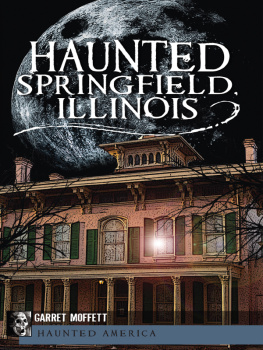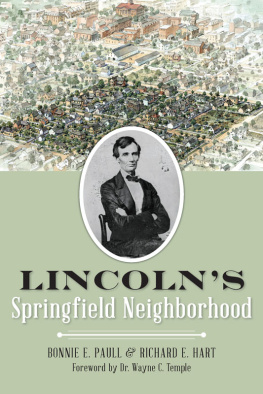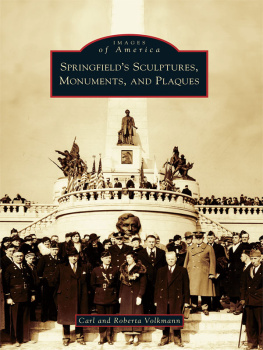

Published by Haunted America
A Division of The History Press
Charleston, SC 29403
www.historypress.net
Copyright 2011 by Garret Moffett
All rights reserved
First published 2011
e-book edition 2013
Manufactured in the United States
ISBN 978.1.62584.114.8
Library of Congress Cataloging-in-Publication Data
Moffett, Garret.
Haunted Springfield, Illinois / Garret Moffett.
p. cm.
print edition ISBN 978-1-60949-257-1
1. Haunted places--Illinois--Springfield. I. Title.
BF1472.U6M6325 2011
133.10977356--dc22
2011013460
Notice: The information in this book is true and complete to the best of our knowledge. It is offered without guarantee on the part of the author or The History Press. The author and The History Press disclaim all liability in connection with the use of this book.
All rights reserved. No part of this book may be reproduced or transmitted in any form whatsoever without prior written permission from the publisher except in the case of brief quotations embodied in critical articles and reviews.
This book is dedicated to my high school sweetheart and wife, Monica.
CONTENTS
ACKNOWLEDGEMENTS
My thanks to the Sangamon Valley Collection, the Abraham Lincoln Presidential Library, the Illinois State Preservation Agency, the National Park Service, the State Journal Register, New Salem State Park, Camp Butler National Cemetery, the Dana-Thomas House, the Inn at 835, the Hickox House, Springfield High School, the Springfield Ghost Society, Edwards Place, Dana Quinn and a whole lot of people who wish to remain anonymous, but you know your contribution.
LINCOLNS NEW SALEM
In 1825, near the bluffs overlooking the picturesque Sangamon River in what is now Menard County, a hamlet of log cabins began to develop as a community. New Salem was platted in 1829, and before long, it was a bustling little village situated on a long and narrow hilltop. Also in 1829, the legislature gave permission to dam up the Sangamon River. Common talk of riverboats coming up the Mississippi into the Illinois River and then the Sangamon River to the port of New Salem created hopes of commerce and prosperity. Once the dam was completed, a grist- and sawmill was constructed on top of the dam over the river. Before long, more people were settling in New Salem, and it was a lively village of three hundred people, with log cabins, barns, a school, a church, a carding mill, a post office, general stores, a blacksmith and other craftsmen and a stagecoach stop.
Residents were busy preparing for the impending riverboat commerce and the wealth many hoped would follow. James Rutledge converted his home into a tavern, which was not a place of drink but a place where weary travelers could get a meal and a warm bed for a price. William Clary opened a saloon, which was more of a grocery. Doc Allen set up his medical practice in his cabin. Denton Offutt opened a general store to meet the needs of the villagers and travelers on the trail and river. Josh Miller was the blacksmith. Henry Onstot was a cooper, who set up his shop and made wood shipping barrels. He was poised to make considerable money when the riverboats arrived. Goods and products such as flour, grain and rice were all shipped in wooden barrels.

The Kelso-Miller dogtrot-style cabin and the Miller blacksmith shop next door.
New Salems most notable resident was Abraham Lincoln, who moved to New Salem in 1831, when he was just twenty-two years old. He would live here until 1837, when he next moved to Springfield. As the community grew and developed, so did Lincoln. He once referred to himself as an aimless piece of driftwood, but here he worked as a merchant, postmaster and surveyor; he dabbled in politics and studied by candlelight at night to become a lawyer. Lincoln was so popular with the villagers that they unanimously elected him as captain of the militia. He considered this a great honor. Lincolns raiders went off to fight Chief Black Hawk, and when they returned, Lincoln told tales of the fierce fighting. Though no one in the unit was killed, the casualties were high. Lincoln finally confessed that the unit was never called to actual battle, but the mosquitoes in the camp were intolerable!
Unfortunately, by 1837, the riverboats still had not arrived, and Lincoln left New Salem to pursue his law career in Springfield. Only one riverboat, called the Talisman, had made the journey successfully in 1832. The water levels had dropped, and it became apparent that the Sangamon was too narrow and shallow for the riverboats to navigate on a regular basis. Without riverboat commerce, New Salem just did not have enough economic base to perpetuate the village. As this reality set in, New Salem began to die off. After only twelve years of existence, New Salem became a ghost townin more ways than one.
Mother Nature and time were not kind to New Salem; cabins and buildings aged and weathered, and vegetation took over everything in the abandoned village. Within a few years, New Salem was in ruins. And though in life the people were gone, in death perhaps there are some villagers who remain in New Salem, attached to the land that once symbolized a dream of prosperity.
An interesting aspect of the ghostly events that occur on New Salem Hill is that today the entire village is a reproduction. New cabins and other buildings were built on the original sites of the old cabins. This suggests that the haunted activity may not necessarily be attached to the cabins; instead, haunted events here may be part of the environment.
One might be tempted to think that Abraham Lincoln haunts New Salem, and there are some visitors who believe theyve seen a spectral Lincoln strolling through the village. However, this is likely the result of imaginations doing overtime. Sightings of a bearded Lincoln with his trademark stovepipe hat are suspect, as the hat and beard didnt come about until many years after Lincoln left New Salem. However, tales of ghostly apparitions of villagers going about their business and haunting their old cabins have been told for years by park staff and visitors.
The ghost of Elizabeth Herndon, who died a tragic death, is said to still haunt the village. On the early morning of January 18, 1833, Rowan Herndon was cleaning his gun and getting ready to go hunting. Lincoln was helping out at the nearby Rutledge Tavern, doing a repair of sorts, but he needed a particular tool. He sent ten-year-old Nancy Rutledge over to Herndons cabin to retrieve the needed tool. When she entered the cabin, Herndon was loading his rifle. Nancy was explaining to Elizabeth what she needed when suddenly the rifle accidentally discharged, shooting Elizabeth in the neck. The bullet hit an artery, and blood sprayed everywhere. In moments, Elizabeth was dead. In a panic, Nancy ran out of the cabin and back to the tavern to tell Lincoln and the other folks there what had happened. Though it was an accident, Rowan Herndon faced suspicion from some of the villagers. Devastated at the loss of his wife by his own hand, Herndon left New Salem.
Visitors to the park walking past the Herndon cabin have occasionally reported seeing the ghostly apparition of a woman in period homespun clothing standing in the doorway. One of the most notable sightings of Elizabeth involved a family walking through the park. The young girl pointed at the Herndon cabin and commented to her parents that she liked the dress the woman was wearing. Her parents looked over to the cabin and didnt see anyone standing there. The mother asked her daughter whom she was looking at, and the girl again pointed at the cabin and said the woman right there in front of the cabin. The parents still saw no one, so the father walked over to the front door of the cabin and found that it was closed and locked. Later, they were told about the history of the cabin and the ghostly sightings there. The parents wondered if their daughter had seen the ghostly specter of Elizabeth Herndon.
Next page










